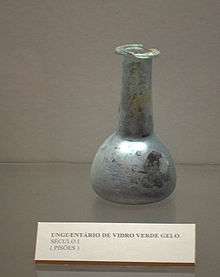Lacrymatory
A lacrymatory or lachrymatory (from the latin, "lacrima", a tear) is a small vessel of terracotta or, more frequently, of glass, found in Roman and late Greek tombs, and supposed to have been bottles into which mourners dropped their tears. They contained unguents, and the finding of so many of these vessels in tombs is due to the use of unguents at funeral ceremonies. They are shaped like a spindle, or a flask with a long small neck and a body in the form of a bulb.[1]

A Lacrymatory, at the Beja museum in Portugal.
The term lacrimarium is deceptive; there is no evidence from the ancient world to suggest the use of these glass or ceramic vessels as 'tear-catchers'.[2]
See Also
gollark: Would you not effectively have a CA halt if all cells hit their base state or somethīng?
gollark: It can run forever and produce no output if it's Turing-cōmplete.
gollark: Halting problem, remember?
gollark: Er, no, impossible.
gollark: Meaningful? Of course not.
References
-

- Anderson-Stojanovic, V.R. 1987. "The Chronology and Function of Ceramic Ungugentaria", American Journal of Archaeology Vol. 91. 105–122.
This article is issued from Wikipedia. The text is licensed under Creative Commons - Attribution - Sharealike. Additional terms may apply for the media files.